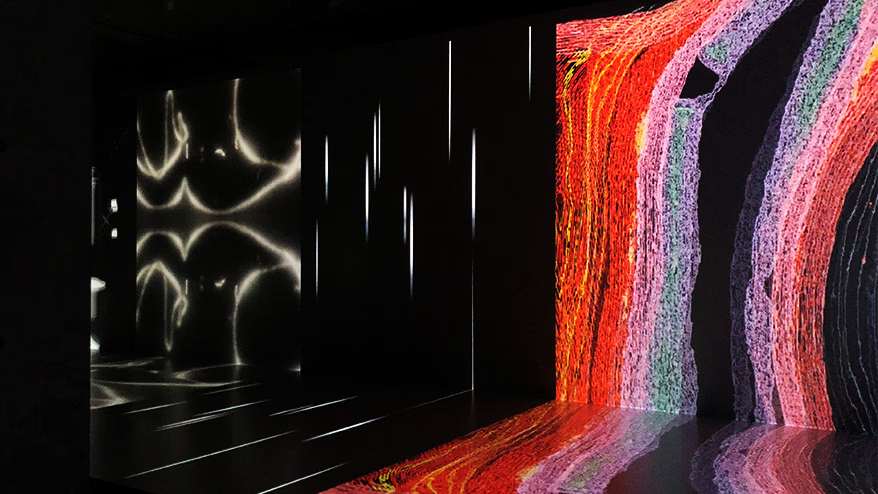I'm Onogi, a designer. On the recommendation of Iwaki, one of Monosus's leading art lovers, I went to the "AUDIO ARCHITECTURE: Sound Architecture Exhibition" held at 21_21 DESIGN SIGHT in Roppongi. The exhibition director is Yugo Nakamura of tha ltd ., who is highly regarded in the fields of interfaces and video.
Personally, I really like the work of Yugo Nakamura. I was originally a Flash creator, and when I was a newbie, a senior designer showed me his work "Monalisa Nervous Matrix" (1999), which was made with Flash, and I remember being blown away (please Google it if you don't know it).
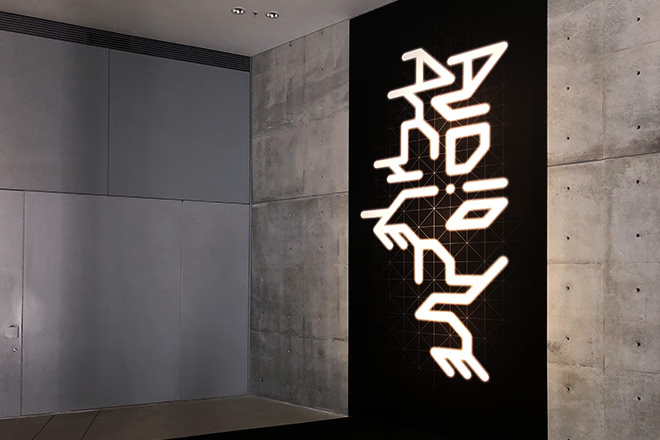
Venue Lobby
This exhibition features a collection of works in which up-and-coming artists have "translated" the new song "AUDIO ARCHITECTURE" written by musician Keigo Oyamada (Cornelius) into video through their own filters.
This concept is also reflected in the exhibition space, where in the first gallery visitors can experience a live studio video work by Tetsuro Inagaki, and in the next gallery, Gallery 2, visitors can watch translated videos by the remaining eight groups all at once on a large screen.
Studio live footage
Immediately upon entering, in Gallery 1, you will see a live studio video of "AUDIO ARCHITECTURE." The artist is Tetsuro Inagaki. Right behind it is a screen from the music software "Pro Tools" laid out like a video work, and lyrics are visualized as an interaction that accompanies the song. It's easy to get fascinated by the live studio video, but if you watch the video as well, you'll enjoy it even more.

Studio live footage: Tetsuro Inagaki
A dynamic visual world created by eight artists
When you enter Gallery 2, you will see a loop of video works by the remaining eight artists. Everyone sits in front of the large screen and is immersed in a world of mixed senses of sight and sound. The sense of immersion is extraordinary. Behind the screen, there are individual booths for the eight artists, where you can take a closer look at their concepts and works.

Below is information about the artists and their works.
Keita Onishi: Cocktail Party in the AUDIO ARCHITECTURE
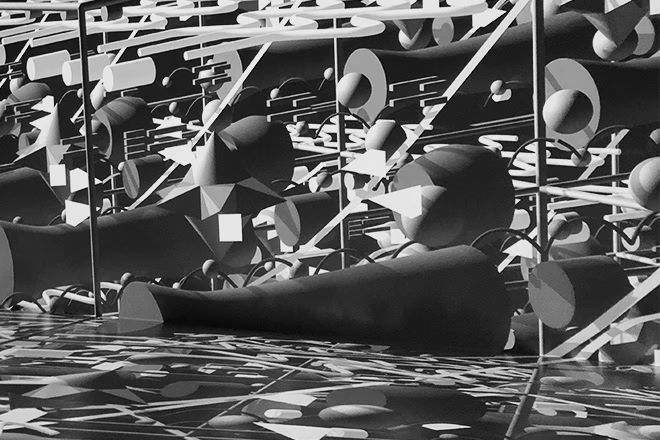
This work captures various sounds, such as drums and voices, individually and interprets them as motion graphics elements. The moment you watch it, you feel the music and the video are linked, so it's a very easy work to understand. In the second half, the video takes on a deep pattern that is overwhelming. As it says in the pamphlet you receive when you enter, you can enjoy the strange sensation of "hearing" what you "see."
Ryo Orikasa: Endgame Study
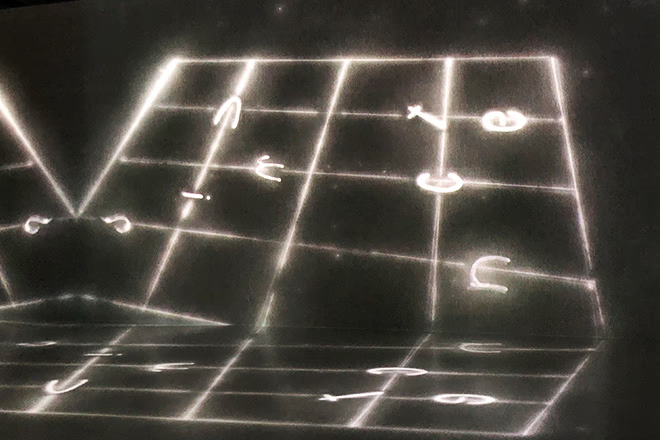
The letters of the lyrics change into abstract animation. The letters seem to respond to the atmosphere and size of the music in the song, giving the piece a sense of life. Personally, this was the most emotional video I've ever seen. Like insects and plankton... each one is ephemeral, but they're definitely "alive." Don't just stare blankly, pay attention to the words and movements.
Hiroaki Umeda: Fibrous
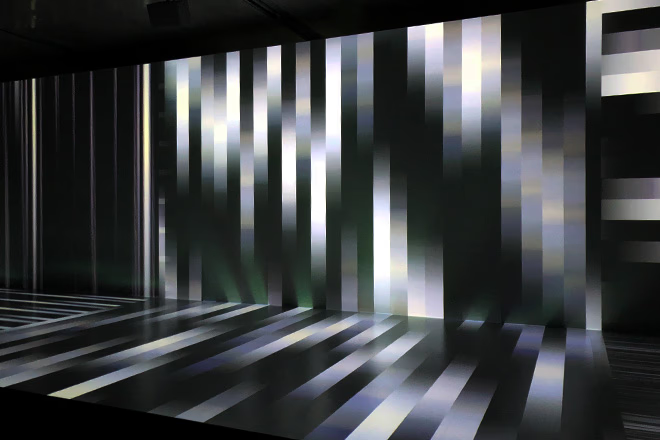
This was the piece that captivated me the most this time. The sense of immersion was simply amazing. Graphics with muscle fibers as a motif rushed by at breakneck speed, and I was at the mercy of the images that changed in sync with the rhythm of the music, wondering whether I was watching it, whether I was there, whether I was moving forward, or backward... Perhaps it was the extra-large screen that helped make this a truly great experience.
Kazumasa Teshigahara: Musical Earthworms
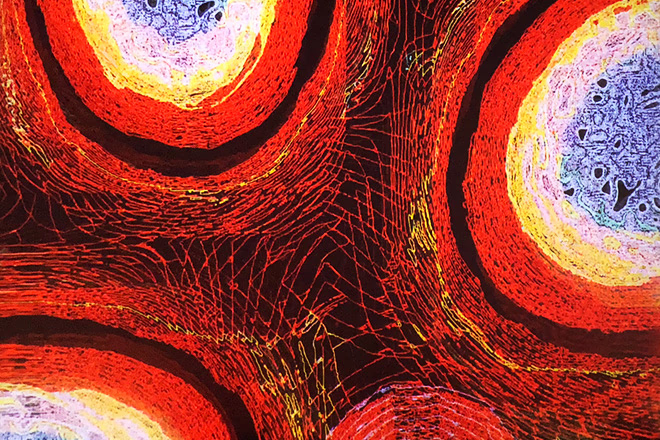
This piece captures music as something that "pulses like life." It was a little difficult for me to understand. I was overwhelmed, but I was more interested in how it was made. As a picture, the visual beauty is wonderful, and as the word "pulsating" suggests, the powerful images that throb and dig deep into your brain are definitely worth a look.
UCNV: Another Analogy
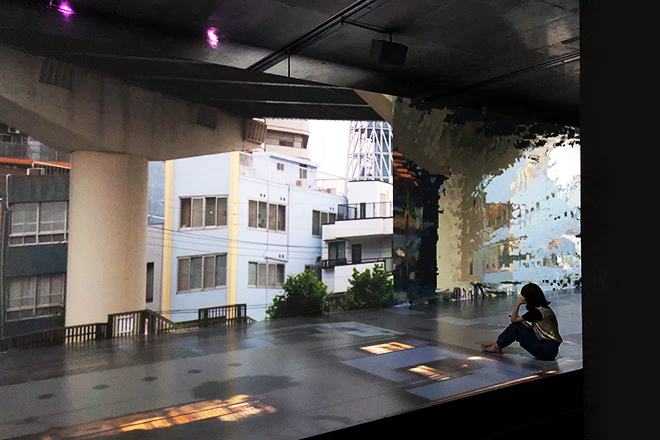
A work that juxtaposes normal and broken images (in the photo above, the broken image is in the background). The lyrics of the song "AUDIO ARCHITECTURE" are composed of "antonyms," and they are expressed in the video. As explained at the beginning, behind this large screen, the works of each artist are individually exhibited, but this work may be easier to understand because the monitor is small and it is easier to recognize the two images at the same time. The interesting images, which have been intentionally removed, and the song jump out at you with a good balance.
Mizushiri Jiko: airflow
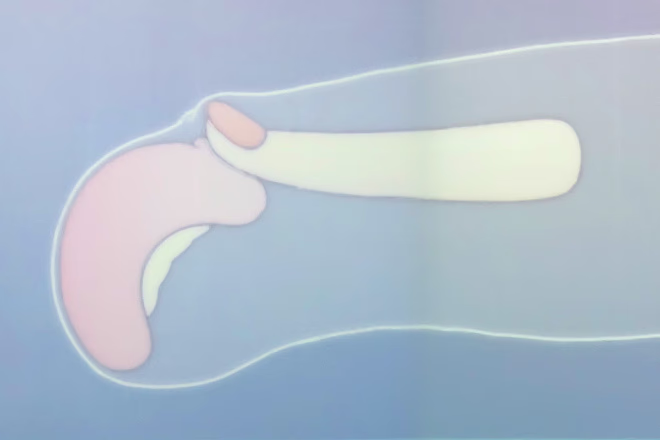
The animation movement, attention to curves, color usage and style were all new to me. I've always been interested in Mizushiri Yoshiko's work, but I never had a chance to see it properly, so I'm really glad I was able to see it this time. I think I should have felt the artistic quality and the combination with the music, but I also like drawing, so I felt like I learned a lot from it! The way the wrinkles form, the way the lines bend, everything is pleasing, so I think it would be good if you could take a look at those little details as well.
Euphrates (Masaya Ishikawa) + Shun Abe: Layers Act
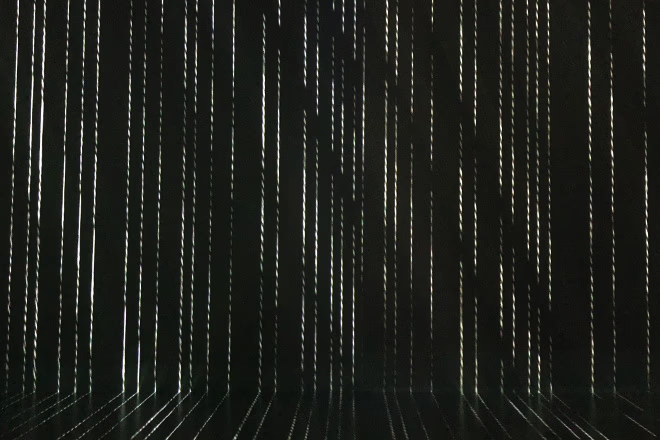
At first, I wondered if the aforementioned "fibrous" had started again. But then I thought, "Oh, so that's how it is!" This is the most unexpected work. If I say too much, it will be a spoiler, so I'll stop here.
Koichiro Tsujikawa (GLASSLOFT) x Bascule x Kitasenju Design: JIDO-RHYTHM
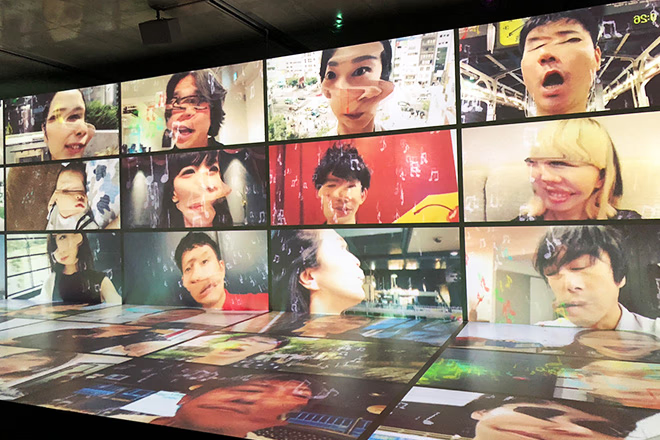
This is an app work. You can experience a music video in which you project yourself into the song. Various effects are applied to your face, and it's just fun. When I went back to my parents' house the other day, I showed it to my two daughters on the train, and they fought over it for about 30 minutes (laughs). If you go too far with art, children won't understand it, but it's great when it's something that both adults and children can enjoy. I also envy the children of today who can encounter such works from a young age.
Even as technology develops,
The richness of human sensibility is important.
That's the simple introduction, but I've intentionally kept the number of photos to a minimum. As I was writing this, I realized that it's nonsense to try to convey the story using so many photos of a video work (laughs).
In summary, I think that human sensibility is flexible. Even though the interpretations were born from one song, there is a wide variety, and each one feels new. Not only the creator's sense, but also the sense of the receiver at the venue is flexible. Not only can it be judged simply as good or bad, but emotions and interpretations probably vary from person to person. It is said that as technology develops, there is less that humans can do and should do, but this is not true. After all, the filter of human sensibility is great! I thought that again.
I hope that reading this article will inspire even a little bit of you to go. It's a space that you can easily enjoy for over an hour, so please do go!
21_21 DESIGN SIGHT - Special Exhibition "AUDIO ARCHITECTURE: Architecture of Sound"
Date: June 29th (Friday) - October 14th (Sunday), 2018
Closed: Tuesdays Opening hours: 10:00 - 19:00 (entrance until 18:30)
Admission fee: 1,100 yen for adults, 800 yen for university students, 500 yen for high school students, free for junior high school students and younger Venue: 21_21 DESIGN SIGHT Gallery 1 & 2
http://www.2121designsight.jp/
9-7-6 Akasaka, Minato-ku, Tokyo 107-0052
Tokyo Midtown Midtown Garden
